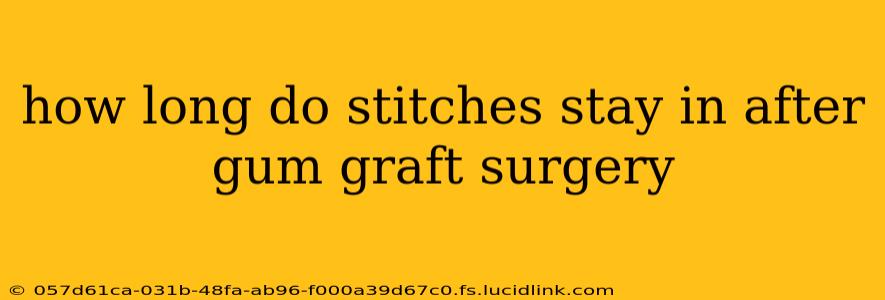Gum graft surgery, also known as gingival grafting, is a common periodontal procedure used to treat gum recession, where the gum tissue pulls back, exposing the tooth roots. Understanding the post-operative care, including stitch removal, is crucial for a successful recovery. So, how long do stitches stay in after gum graft surgery? The answer isn't a simple number, but rather a range dependent on several factors.
What Determines Stitch Removal Timing After a Gum Graft?
The time your stitches remain in place after gum graft surgery depends primarily on:
-
Type of suture material: Some sutures (stitches) are dissolvable, meaning they'll break down and be absorbed by your body over time. Others are non-dissolvable and require removal by your dentist or periodontist. Dissolvable stitches typically take 1-2 weeks to fully dissolve.
-
Surgical technique: The specific surgical technique employed by your periodontist will influence the healing process and therefore the timing of stitch removal. More complex procedures may require stitches to remain in place longer for optimal healing.
-
Healing progress: Your body's individual healing response plays a significant role. Faster healing may allow for earlier removal, while slower healing necessitates a longer stitch retention period. Your dentist will assess your healing progress at follow-up appointments.
-
Location and extent of the graft: Larger grafts or grafts in areas prone to movement may require longer stitch retention for proper healing and stability.
How Long is Typical?
While there's no single definitive answer, most patients can expect their stitches to be removed or fully dissolved within 7 to 14 days following gum graft surgery. However, some patients may require stitches for a longer duration, up to three weeks.
What if my stitches dissolve too quickly?
Premature dissolution of dissolvable stitches can occasionally lead to complications if the gum tissue is not adequately healed and supported. It's important to contact your dentist or periodontist immediately if you notice any signs of this or any other post-operative complications.
What if my stitches are still in place after 2 weeks?
If your stitches are non-absorbable, your dentist or periodontist will schedule a follow-up appointment to remove them. Do not attempt to remove them yourself.
What Happens During Stitch Removal?
Stitch removal is a quick and relatively painless procedure. Your dentist or periodontist will use small surgical scissors to carefully cut and remove the sutures. You may experience a slight pinch or tugging sensation, but it's typically well-tolerated.
Post-Stitch Removal Care
After stitch removal, your gums may be slightly tender or sensitive for a short period. Your dentist will provide specific post-operative instructions, but generally, you should:
- Avoid brushing the area vigorously: Use a soft-bristled toothbrush and gentle brushing technique.
- Maintain good oral hygiene: Brush and floss regularly to prevent infection.
- Avoid smoking: Smoking significantly impairs healing.
- Follow your dentist's dietary recommendations: A soft food diet may be suggested for the first few days.
Post-Operative Complications: When to Seek Medical Attention
While most gum graft surgeries heal without issues, it's important to watch for signs of infection or complications, such as:
- Increased pain or swelling: Significant increases in pain or swelling beyond the initial post-operative period warrant a call to your dentist or periodontist.
- Excessive bleeding: Bleeding that doesn't stop after applying gentle pressure should be addressed immediately.
- Signs of infection: These include pus, fever, or red streaks extending from the surgical site.
Remember, this information is for general knowledge and should not replace advice from your dentist or periodontist. They can best assess your individual needs and provide tailored advice about your recovery and stitch removal. Always follow their specific post-operative instructions diligently.
